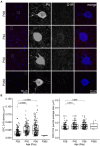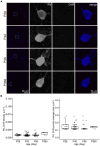Age-related changes of dopamine D1 and D2 receptors expression in parvalbumin-positive cells of the orbitofrontal and prelimbic cortices of mice
- PMID: 38903598
- PMCID: PMC11187244
- DOI: 10.3389/fnins.2024.1364067
Age-related changes of dopamine D1 and D2 receptors expression in parvalbumin-positive cells of the orbitofrontal and prelimbic cortices of mice
Abstract
Dopamine (DA) plays a pivotal role in reward processing, cognitive functions, and emotional regulation. The prefrontal cortex (PFC) is a critical brain region for these processes. Parvalbumin-positive (PV+) neurons are one of the major classes of inhibitory GABAergic neurons in the cortex, they modulate the activity of neighboring neurons, influencing various brain functions. While DA receptor expression exhibits age-related changes, the age-related changes of these receptors in PV+ neurons, especially in the PFC, remain unclear. To address this, we investigated the expression of DA D1 (D1R) and D2 (D2R) receptors in PV+ neurons within the orbitofrontal (OFC) and prelimbic (PrL) cortices at different postnatal ages (P28, P42, P56, and P365). We found that the expression of D1R and D2R in PV+ neurons showed both age- and region-related changes. PV+ neurons in the OFC expressed a higher abundance of D1 than those in the PrL, and those neurons in the OFC also showed higher co-expression of D1R and D2R than those in the PrL. In the OFC and PrL, D1R in PV+ neurons increased from P28 and reached a plateau at P42, then receded to express at P365. Meanwhile, D2R did not show significant age-related changes between the two regions except at P56. These results showed dopamine receptors in the prefrontal cortex exhibit age- and region-specific changes, which may contribute to the difference of these brain regions in reward-related brain functions.
Keywords: D1; D2; age; development; dopamine receptor; orbitofrontal cortex; prefrontal cortex.
Copyright © 2024 Dong, Wei, Huang, Tian and Zhang.
Conflict of interest statement
The authors declare that the research was conducted in the absence of any commercial or financial relationships that could be construed as a potential conflict of interest.
Figures








Similar articles
-
Distinct Roles for Prefrontal Dopamine D1 and D2 Neurons in Social Hierarchy.J Neurosci. 2022 Jan 12;42(2):313-324. doi: 10.1523/JNEUROSCI.0741-21.2021. Epub 2021 Nov 29. J Neurosci. 2022. PMID: 34844989 Free PMC article.
-
Dopamine D1 or D2 receptor-expressing neurons in the central nervous system.Addict Biol. 2018 Mar;23(2):569-584. doi: 10.1111/adb.12512. Epub 2017 Apr 24. Addict Biol. 2018. PMID: 28436559 Free PMC article.
-
Retrograde Labeling Illuminates Distinct Topographical Organization of D1 and D2 Receptor-Positive Pyramidal Neurons in the Prefrontal Cortex of Mice.eNeuro. 2020 Oct 26;7(5):ENEURO.0194-20.2020. doi: 10.1523/ENEURO.0194-20.2020. Print 2020 Sep/Oct. eNeuro. 2020. PMID: 33037031 Free PMC article.
-
Effect of maternal lipopolysaccharide administration on the development of dopaminergic receptors and transporter in the rat offspring.PLoS One. 2013;8(1):e54439. doi: 10.1371/journal.pone.0054439. Epub 2013 Jan 17. PLoS One. 2013. PMID: 23349891 Free PMC article.
-
Laminar and Cellular Distribution of Monoamine Receptors in Rat Medial Prefrontal Cortex.Front Neuroanat. 2017 Sep 28;11:87. doi: 10.3389/fnana.2017.00087. eCollection 2017. Front Neuroanat. 2017. PMID: 29033796 Free PMC article. Review.
References
-
- Banks P. J., Burroughs A. C., Barker G. R., Brown J. T., Warburton E. C., Bashir Z. I. (2015). Disruption of hippocampal-prefrontal cortex activity by dopamine D2R-dependent LTD of NMDAR transmission. Proc. Natl. Acad. Sci. U.S.A. 112, 11096–11101. doi: 10.1073/pnas.1512064112, PMID: - DOI - PMC - PubMed
LinkOut - more resources
Full Text Sources
Research Materials
Miscellaneous

